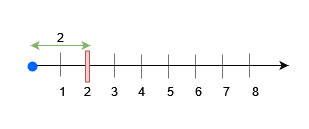
g3101_3200.s3161_block_placement_queries.readme.md Maven / Gradle / Ivy
Go to download
Show more of this group Show more artifacts with this name
Show all versions of leetcode-in-java Show documentation
Show all versions of leetcode-in-java Show documentation
Java-based LeetCode algorithm problem solutions, regularly updated
The newest version!
3161\. Block Placement Queries
Hard
There exists an infinite number line, with its origin at 0 and extending towards the **positive** x-axis.
You are given a 2D array `queries`, which contains two types of queries:
1. For a query of type 1, `queries[i] = [1, x]`. Build an obstacle at distance `x` from the origin. It is guaranteed that there is **no** obstacle at distance `x` when the query is asked.
2. For a query of type 2, `queries[i] = [2, x, sz]`. Check if it is possible to place a block of size `sz` _anywhere_ in the range `[0, x]` on the line, such that the block **entirely** lies in the range `[0, x]`. A block **cannot** be placed if it intersects with any obstacle, but it may touch it. Note that you do **not** actually place the block. Queries are separate.
Return a boolean array `results`, where `results[i]` is `true` if you can place the block specified in the ith query of type 2, and `false` otherwise.
**Example 1:**
**Input:** queries = [[1,2],[2,3,3],[2,3,1],[2,2,2]]
**Output:** [false,true,true]
**Explanation:**
****
For query 0, place an obstacle at `x = 2`. A block of size at most 2 can be placed before `x = 3`.
**Example 2:**
**Input:** queries = [[1,7],[2,7,6],[1,2],[2,7,5],[2,7,6]]
**Output:** [true,true,false]
**Explanation:**
****
* Place an obstacle at `x = 7` for query 0. A block of size at most 7 can be placed before `x = 7`.
* Place an obstacle at `x = 2` for query 2. Now, a block of size at most 5 can be placed before `x = 7`, and a block of size at most 2 before `x = 2`.
**Constraints:**
* 1 <= queries.length <= 15 * 104
* `2 <= queries[i].length <= 3`
* `1 <= queries[i][0] <= 2`
* 1 <= x, sz <= min(5 * 104, 3 * queries.length)
* The input is generated such that for queries of type 1, no obstacle exists at distance `x` when the query is asked.
* The input is generated such that there is at least one query of type 2.© 2015 - 2024 Weber Informatics LLC | Privacy Policy